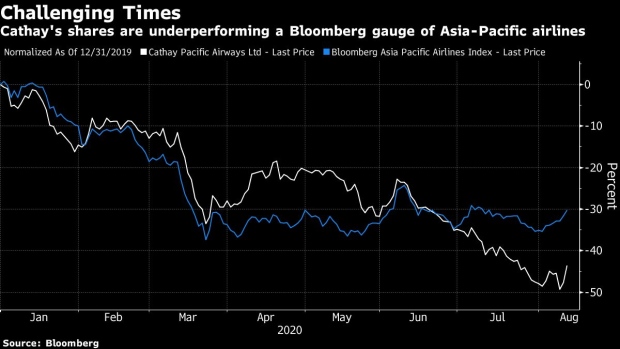Aug 12, 2020
Cathay Warns Biggest Crisis to Persist After $1.3 Billion Loss
, Bloomberg News

(Bloomberg) -- Cathay Pacific Airways Ltd. said it doesn’t expect to see any meaningful recovery in business for some time, after it posted a first-half net loss of HK$9.9 billion ($1.3 billion) as the coronavirus pandemic brought global travel to a near standstill.
The airline and its Cathay Dragon unit flew 4.4 million passengers in the first six months, compared with 18.3 million people a year earlier. Passenger revenue tumbled 72% to HK$10.4 billion during the period, Cathay said in a statement Wednesday. It flew an average of just 500 passengers a day in April and May. Hong Kong Express, which Cathay bought in July 2019, suspended services in March and only began resuming some flights in August. The low-cost unit posted a “significant loss” in the first half, Cathay said.
The company already warned of the loss, which includes impairment charges of HK$2.5 billion relating primarily to 16 aircraft unlikely to return to meaningful economic service again.
“The global health crisis has decimated the travel industry and the future remains highly uncertain, with most analysts suggesting that it will take years to recover to pre-crisis levels,” Chairman Patrick Healy said in Wednesday’s statement.
Cathay’s shares climbed as much as 11% to HK$5.84 ahead of the results, the most in two months in intraday trading.
Covid-19 struck just as Cathay was trying to rebuild following protests in Hong Kong that led to changes in senior management and a sharp drop in traffic in the latter part of 2019, with the city eventually falling into recession. Net income plunged to HK$344 million in the second half, which is typically a stronger period, from about HK$1.4 billion in the first half of last year. Unlike most airlines, Cathay has no domestic market to fall back on.
The pandemic made matters much more grave for Cathay and airlines in the U.S. and elsewhere, many of which are relying on government aid to survive. Several have collapsed. Cathay unveiled a HK$39 billion rescue plan in June that gives the Hong Kong government a 6.08% stake in the company and two observers on its board. The recapitalization was completed Wednesday. The carrier’s main shareholders are Swire Pacific Ltd., Air China Ltd. and Qatar Airways.
“Despite a promising start in January, with encouraging signs that passenger demand was beginning to return following the social unrest which impacted the second half of 2019, the first six months of 2020 were the most challenging that the Cathay Pacific Group has faced in its more than 70-year history,” Healy said.
The outlook remains extremely challenging as the virus spreads, with confirmed infections topping 20 million this week. The International Air Transport Association doesn’t expect the global airline industry to recover to pre-virus levels before 2024.
However, there are signs of recovery as domestic travel rebounds in some markets, including mainland China. Worldwide commercial air traffic volume is about 50% of this time last year, the highest since the start of the downturn, according to FlightAware.
One bright spot for Cathay was its cargo operations, with revenue rising 8.8% from a year earlier to HK$11.2 billion and load factor increasing 5.9 percentage points to 69.3%.
“There was an imbalance between capacity and demand in the cargo market, which led to higher cargo revenues compared to the first half of 2019,” Healy said.
Freight operations have helped other airlines too, including Korean Air Lines Co. and Asiana Airlines Inc., both of which posted quarterly operating profits as consumers continued snapping up Korean goods such as smartphones and TVs.
The jump in Cathay’s shares Wednesday morning trimmed their year-to-date loss to 43%, still among the worst performers on a Bloomberg gauge of Asia-Pacific airlines.
©2020 Bloomberg L.P.